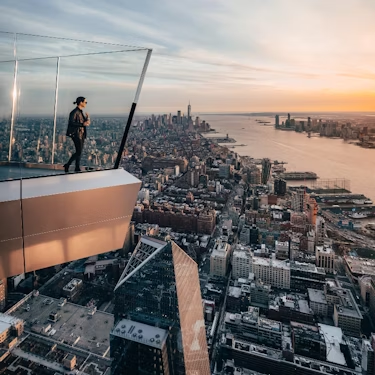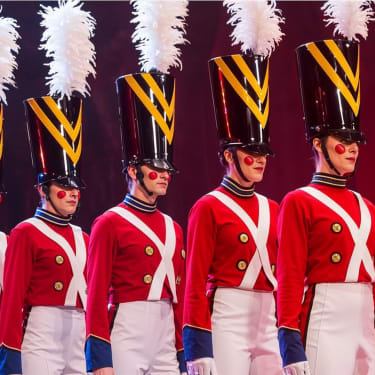More about: 10 Things to Do in Chinatown NYC
Strolling aimlessly through the streets of Chinatown is a joy, because in every street or square you can find a surprise that makes you believe you are in China: a restaurant, a market, a souvenir store, a temple, stores and signs in Chinese ...
There is a very unique atmosphere here that as a traveler catches you. Read on and learn about the must-see and must-do's in the area, so you don't leave anything untracked.

SoHo, Little Italy, and Chinatown Tour
Get to know New York's most peculiar neighborhoods
You will be accompanied by an expert guide through three of New York's most emblematic and original neighborhoods: Chinatown, Soho and Little Italy.
On the Chinatown tour, which lasts about 2 hours, you will feel like you are not in New York. The streets full of Chinese signs, stores and restaurants will leave you impressed. This district is home to one of the largest concentrations of Chinese inhabitants beyond the Chinese border.
On this complete tour with an expert guide, you will also get to know the neighborhoods of Soho and Little Italy, an ideal way to get to know the multiculturalism of New York City!
Recommended if... you want to get to know New York's historic neighborhoods in detail.
1. Discover Columbus Park
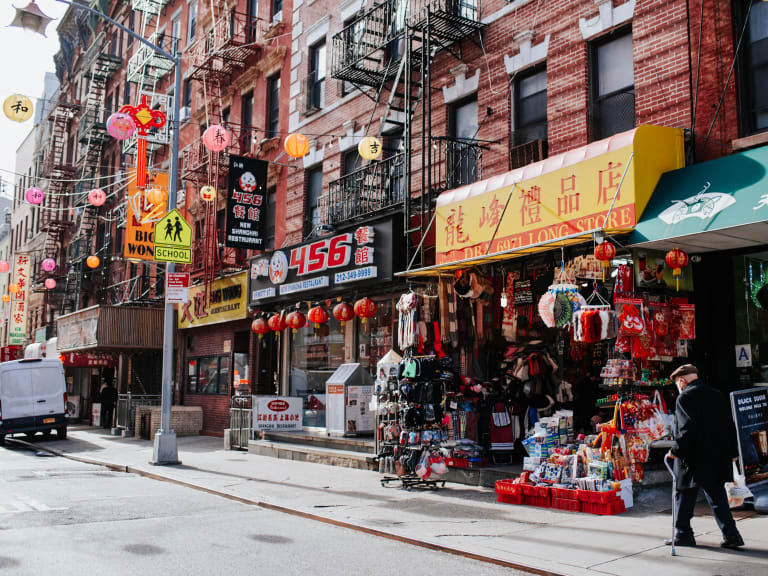
The first contact with Chinatown, without a doubt, should be Columbus Park. It is the largest park in the neighborhood and the usual meeting point for the older members of the Chinese community, as well as one of the places you will visit on the Chinatown tour.
It is very common to see them every morning on the benches reading the newspaper, getting together to keep fit practicing taichi, to play a few games of mahjong and even to play musical instruments and sing. There you will see that the ability of the Chinese to keep their traditions alive wherever they go is immense and admirable.
Very close to Columbus Park is the Kimlau War Memorial, erected in honor of Chinese-Americans who fell in combat in defense of freedom and democracy.
2. Visit the Mahayana Buddhist Temple
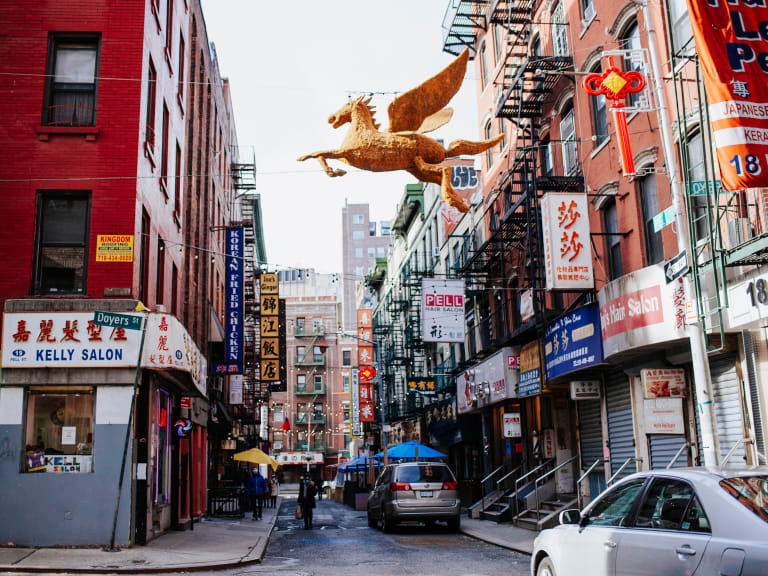
New York is a multicultural city where different religions coexist (you can visit most of them in the famous tour of contrasts). In this sense, there are many temples and you can visit St. Patrick's Cathedral, the Eldridge Street Synagogue, the Cathedral of St. John the Divine or attend a Gospel Mass in Harlem.
But if you want to complete this mystical experience in the Big Apple, you should head to 133 Canal Street in Chinatown, where the Mahayana Buddhist Temple is located, which houses the largest Buddha in the city with 5 meters high. It dates back to 1962 and became the first Buddhist temple on the East Coast.
It is not easy to find, to tell the truth, because its facade does not look like that of a typical Buddhist temple. For this reason, we recommend that you book a tour of Chinatown or that you pay close attention so as not to miss it. Normally to gain access they usually ask for a donation and in return they offer you a fortune paper or incense.
3. Get the best Chinese products in Chinatown
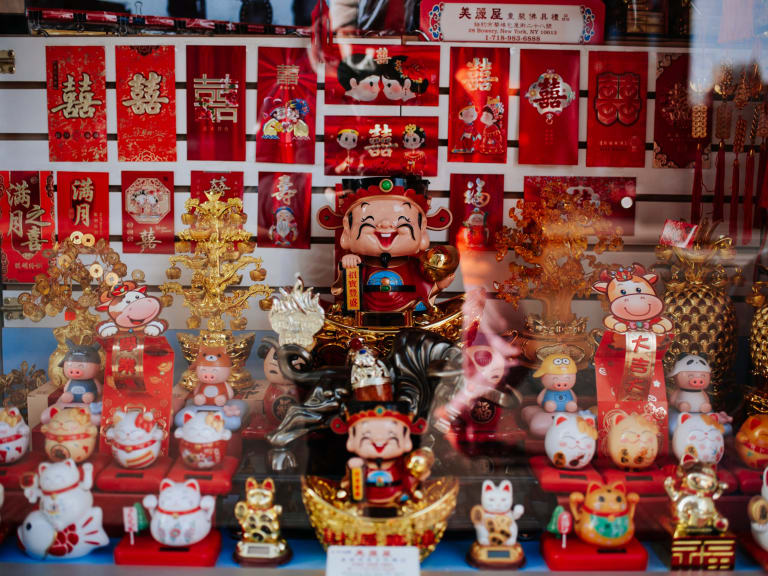
One of my favorite things to do in Chinatown is to browse the bazaars and markets. They sell all kinds of products at very cheap prices. For example, if you walk around the Canal and Mott Street area you will feel as if you were in a real bazaar in China.
Canal Street
It could be said that Canal Street is the entrance to Chinatown, although there is no arch that indicates it. It is the main street of the neighborhood and is somewhat chaotic and noisy because of the large volume of people who pass through it to be here the famous stores of fashion fakes.
However, if you want to take a break and get away from the commotion I advise you to go to Canal Street Market: (265 Canal St), a modern and orderly market that contrasts with the bustling environment that surrounds it. This market is divided into two spaces:
- On the right: a food hall with Asian food stalls.
- On the left: artisan stores selling everything from natural cosmetics and jewelry to decorative objects and handmade chocolate, among other products.
Mott Street
Mott Street, on the other hand, abounds with vegetable, fruit, spice, mushroom and exotic food stores. In fact, many New York restaurants source fresh produce from Chinatown. You'll also find the best Chinatown souvenirs here at a cheaper price than in downtown Manhattan stores.
4. Celebrate Chinese New Year
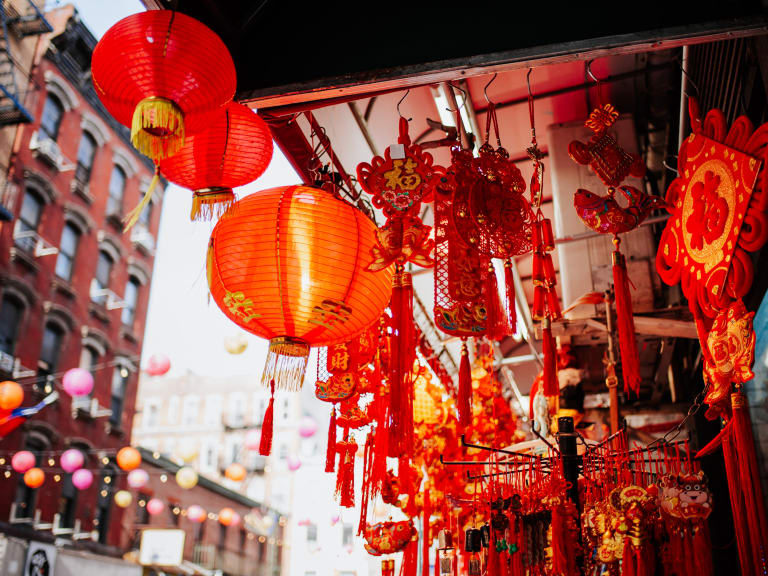
A very special time to visit Chinatown is during the Chinese New Year celebrations, the most important holiday in Chinese culture. The date depends on the lunar calendar, although it usually takes place in February and is celebrated in style.
I have been lucky enough to see it on one occasion and it is very worthwhile. Each year a different animal is welcomed and thousands of people participate in a parade of floats, dances, music and dragons.
It is an event for all ages full of fun and attended by many people. Therefore, I recommend that if you go to see the parade, look for a street crossing from which you can observe it well and experience the atmosphere. When it is over, do not hesitate and go to a restaurant or food stall to enjoy the best Asian cuisine in the heart of Chinatown.
5. Visit the Church of the Transfiguration
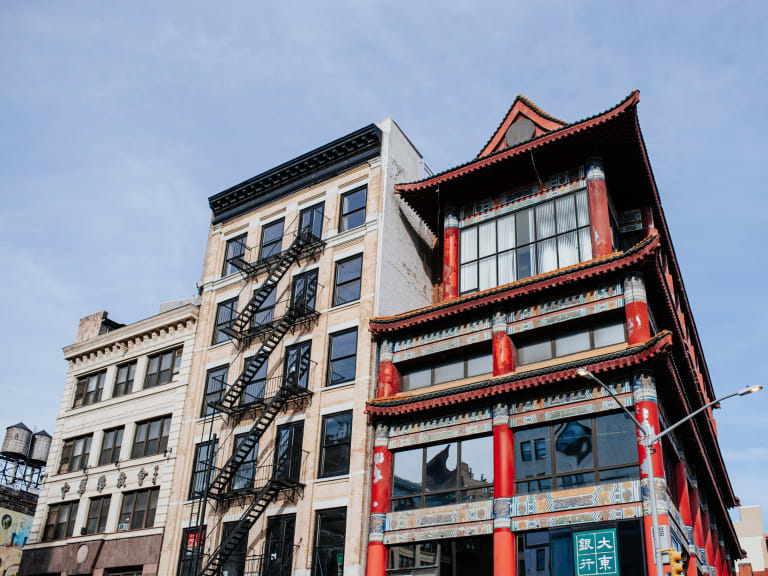
Speaking of temples in Chinatown, if you are interested, after the Chinatown tour, you can visit the Catholic Church of the Transfiguration at 29 Mott Street, which is much older than the Buddhist temple, dating back to 1801. It is attended by Chinese parishioners from the neighborhood as mass is offered in Mandarin, Cantonese and English.
6. Enter the Chinese Museum in America

In addition, you can take advantage of the Chinatown tour to visit the Chinese Museum in America to learn about the history of this community in the U.S. since its beginnings. Opened in 1980, this museum offers a journey through the life of its members since they landed in America through testimonies, images and videos.
An interesting retrospective that helps us to understand the most particular aspects of Chinese culture and the resulting cultural exchange between two worlds, Chinese and American, apparently so different.
The Museum of Chinese in America or MOCA is located at 215 Centre Street. Admission is about $12 and it is open Tuesday through Sunday from 11 am to 6 pm. However, on the first Thursday of every month, admission is free.
7. Stop by Confucius Plaza
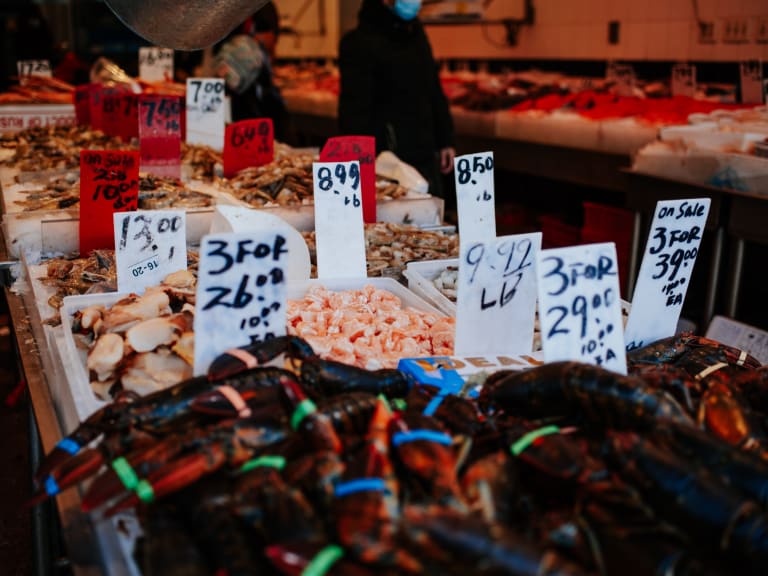
One of the most striking buildings in Chinatown, especially for its height and color, is the historic Confucius Plaza (1975) in front of which stands a statue of Confucius, the famous Chinese philosopher of the 5th century BC.
8. Taste the best Chinese food
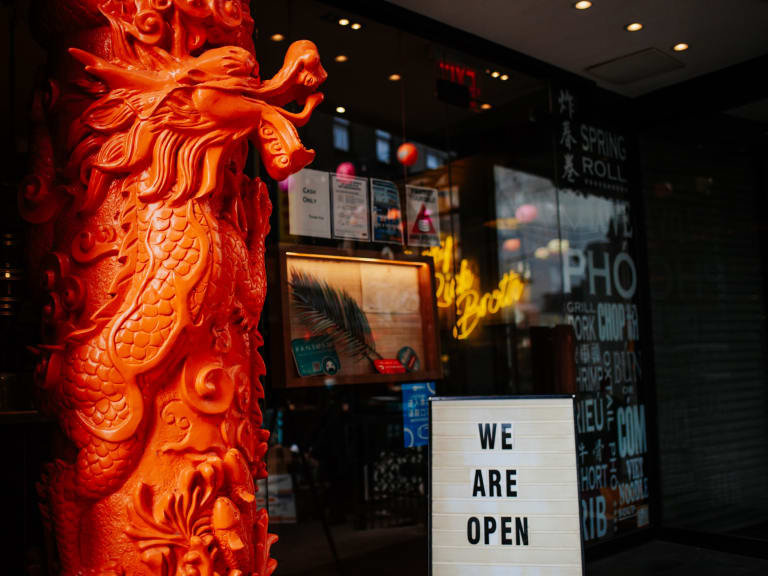
Chinese cuisine is one of the most appreciated in the world for its variety of ingredients, flavors and textures. Beyond the spring rolls and three-delicious rice that we are used to, in Chinatown you will have the opportunity to taste authentic Chinese food at very reasonable prices.
If you love to eat and you are a foodie, in this neighborhood of New York you will enjoy a lot because you will find numerous restaurants and bars where you can try some of the best Asian specialties in Manhattan . These are the best places to eat in Chinatown:
- Xi's an Famous Food: If you like spicy food, you will love this place. The lamb and cumin burger is spectacular as well as the handmade noodles. Plus, the service is lightning fast. It is located at 45 Bayard Street.
- Big Wing Wongt: This is an old-school Cantonese restaurant. The portions here are large and the service is efficient. The roast duck, wontons and fried rice are excellent, although their menu is more extensive. The dim sum is among the best in town in my opinion. Prices? Pretty cheap. You will find this restaurant at 102 Mott Street
- Buddha Bodai: A good option for vegetarians where most dishes cost less than $15. I love it because there is an extensive menu with dishes as tasty as dumplings, spring rolls and different noodle recipes. Also, the vegetarian versions of chicken, lamb or duck are very accomplished and tasty. And if you are looking for dim sum, this is a good place. It is at 5 Mott Street, near Columbus Park.
- Canal Street Market: This food hall specializing in Asian food is perfect to eat if you are visiting Chinatown in a group and everyone wants to order something different. It has several food stalls offering a wide variety of food for less than $15. You can sample the dishes right there or order a take away for a picnic in Columbus Park. Canal Street Market is located at 265 Canal Street.
9. Learn to bargain, but don't fall for fakes
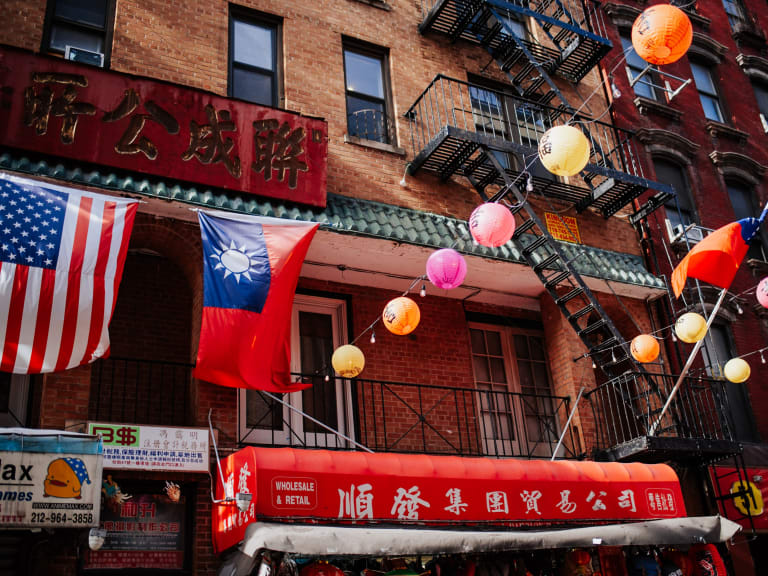
In the local stores it is quite common that you can negotiate prices, especially if you are willing to take several products. Always try to set a maximum price you are willing to pay and be patient to get what you want.
On the other hand, it is well known that in Chinatown you can find counterfeit luxury goods. Honestly, I do not love this practice (first because, of course, it is not legal) but mostly because the products they offer you have no guarantee.
Surely during your walk you will be approached by different street vendors with a catalog (usually they do not carry the products on them to avoid problems with the police) and they will offer you bags, watches, belts and wallets of big brands. If you expect to find bargains, you are wrong: a luxury bag can cost up to 300 dollars. That's why I don't recommend you to invest your money.
10. Take the opportunity to get to know the surroundings: take a walk through Tribeca or Little Italy

If you have enough time, I recommend that you take advantage of your walk through Chinatown to get to know the surrounding streets and neighborhoods such as Little Italy. You'll realize you've crossed the "border" between Chinatown and Little Italy when you start seeing coffee shops, checkered tablecloths and a delicious smell of freshly made pizza.
You'll also find Tribeca. Like so many other areas of New York, it began as an industrial area and later became a bohemian neighborhood, with buildings that feature the typical emergency staircase on the facade and alternative store fronts and small cafes where you can stop for a break.
In addition, you will find small art galleries where you can enter to browse and if you stumble upon a fire station that looks familiar, the Ghostbusters. New York is full of movie sets and if you want to see the best ones, I tell you about them in my article about the best movie and series locations in New York
Where is Chinatown and how to get there?

Chinatown is located in the southeast of Manhattan. It is surrounded by the neighborhoods of Lower East Side (to the east), Tribeca (to the west), Civic Center (to the south) and Little Italy (to the north). However, its borders are blurred as Chinatown has grown so much in recent times that it has almost absorbed Little Italy and much of the Lower East Side.
The easiest way to get to Chinatown is to take the subway, although it can also be reached by bus.
- Subway: Canal Street stop (6, J, M, Z, N, Q, R and W lines) or Grand Street station (B and D lines).
- Bus: M01, M103 and B51 lines.
How was this neighborhood born?
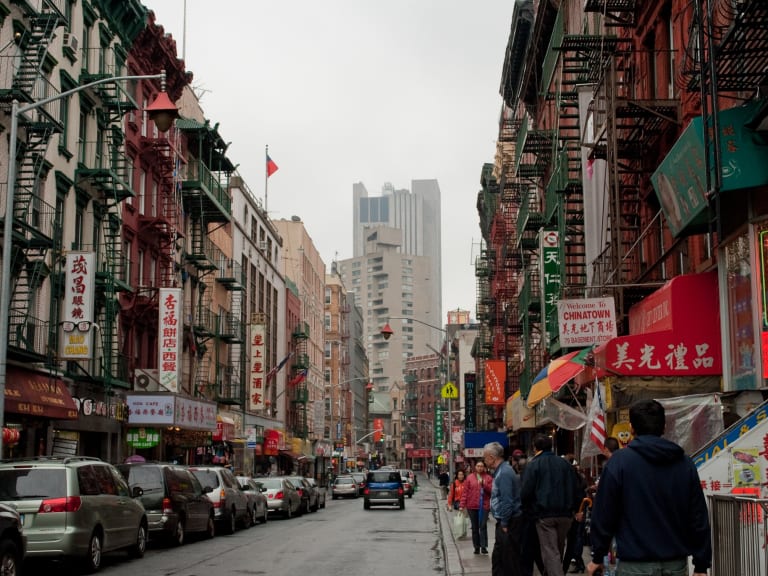
Attracted by the gold rush, thousands of immigrants from China arrived in the U.S. in the mid-nineteenth century. Most of them settled in California, but some moved to the East Coast, specifically to New York.
Historically, the Chinese community has been very hermetic and these immigrants from the beginning sought to settle in areas where their compatriots already lived. The great growth of this New York neighborhood occurred in 1960, when the restrictions on immigration, which had been applied a few decades earlier due to the economic recession of 1873, were no longer so strict and people from Hong Kong and other Cantonese-speaking regions began to arrive.
Chinatown then began to grow and massify until it became a world apart within the Big Apple, with its own internal organization both socially and culturally. In fact, many of its inhabitants barely speak English despite living in New York. And in a way that is part of its charm, that is, the feeling that you travel from one world to another just by crossing a street. For many it is a culture shock.
Other "Chinatowns" in New York
If after exploring Manhattan's Chinatown, which is undoubtedly one of the best neighborhoods in New York, you want to discover more about Chinese culture, you can approach the Chinatowns of Queens and Brooklyn.
Gentrification has displaced many Manhattanites to the other two boroughs of New York. Many people say that the atmosphere here is more genuine than the Lower East Side but, in my opinion, it's just different. It's a matter of taste, really.















